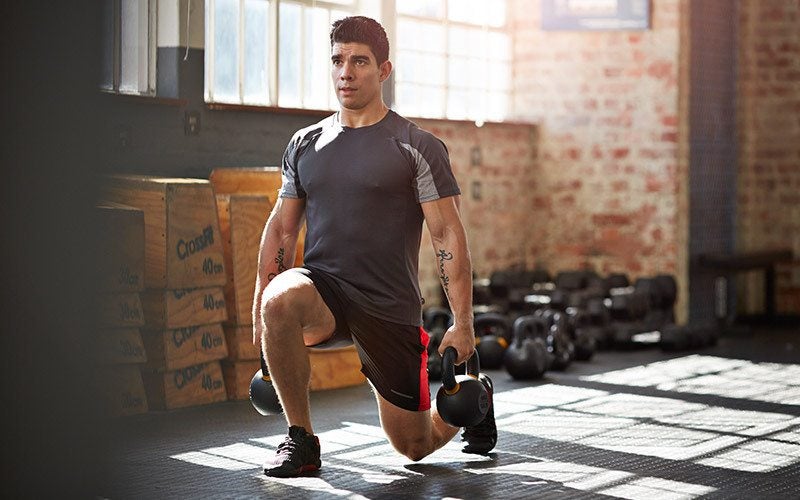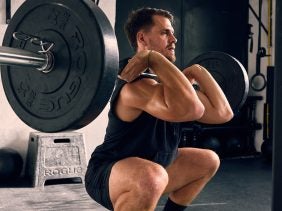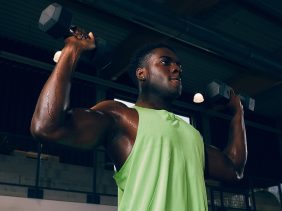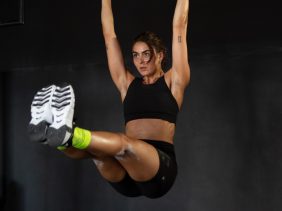11 Exercises for a Crazy Strong Core
 ©Klaus-Vedfelt
©Klaus-Vedfelt
It’s easy to imagine the kinds of athletes intensely focused on core work. Boxers, shot-putters, equestrians, skiers. But it might surprise you to know that pros of all stripes find that having a strong core makes for more success. Football players all need to be bulletproof in the middle. And endurance athletes, too. For instance, a small study published in PLoS One found that collegiate runners who spent two months focusing on more intense core training saw improvements on a treadmill test and oxygen consumption. “These results reveal that 8-233k core training may improve static balance, core endurance, and running economy in college athletes,” the researchers from Hong Kong wrote.
Related: 9 ab exercises to get your core smoking
Even if your college years are behind you, a strong core is essential. Having a strong trunk promotes good posture when sitting, walking, or doing strength training. It provides the balance for running, jumping, dancing, or jetting up the stairs to catch a train. If you’ve ever been complimented for your great coordination, you have your core to thank. And for people who are differently abled, the trunk sometimes takes on the responsibility for absorbing imbalances and taking on a bigger share of force production. And the stronger the core, the more impervious to injury you become. For instance, people who have chronic low back pain can find some relief by doing core strength training, particularly working on their deep trunk muscles, according to Taiwanese researchers.
What are your strengths? What do you want to work? Find out here.
Despite all this, some people treat focused core work as an afterthought. Maybe it comes at the tail end of leg day, when you’re already a little pooped, so the ab work ends up a bit uninspired. We’re making the case that core work deserves your full focus, along with some exercises that’ll inspire you to make it happen.
These supplements will keep your body on tip-top form.
What is core training?
The core stands for core or the middle and thus includes your entire torso. This means that you focus on the middle of your body during core training. The core muscles lie between the diaphragm and the hips. These include the rectus abdominis, obliques, lower back, and hip flexors and extensors.
In contrast to a normal six-pack workout, you train as many areas of your middle as possible. Unlike classic strength training, in which muscles are usually flexed and stretched in isolation, functional movements come into play here that use many different muscles at the same time.
The term core stability refers to how well your core can withstand an imbalance. Strong core muscles act like a shield. You benefit from this both in everyday life when you lose your balance and during training by remaining stable during exercises and complex movements.
11 exercises for your core
With few exceptions, you don’t need more than your own body weight for core training—though a little bit of equipment and a few weights can make a big difference. Pick five or 6 exercises, and do each move for 30 seconds to a minute. Keep the rest between movements as short as possible. Rest at the end of the round, and do 3 or 4 rounds.
- Hip thrust
Start in a reverse tabletop pose, hands under shoulders, hips high, facing ceiling. Slowly drop butt to floor, then quickly reverse to start. Do these at a steady, controlled pace.
- Mountain climbers
Start in a high plank, hands below shoulders, a straight line between heels, shoulder blades, and head. Draw your right knee toward chin, then switch legs so only one foot is on the ground at a time. Continue quickly. If that’s too challenging, slow it down, picking up one foot and replacing it before reversing.
- Plank with hip dips
Start in a low plank, forearms on floor, hands clasped, feet shoulder-width apart. Keeping shoulder blades flat, rotate hips side to side to tap the floor, allowing feet to follow. Repeat continuously.
Refuel: Try our whey protein either before or after exercising.
- Plank with rotation
Start in a low plank, forearms on floor, parallel to shoulder blades and touching each other. Rotate body to the right, letting feet roll to right, as you reach right fingertips to ceiling. Reverse and repeat on left. Continue at a controlled pace.
- Reverse hyperextensions
Lie on stomach, arms and legs outstretched, face down, to start. Engage abs and raise arms and legs up out, keeping gaze on floor. Reverse to start. Continue at a controlled pace.
Related: 7 training tips for athletes to stay fit forever
- Side plank with hip dips
Lie on left side, left forearm on floor, fingers pointed away from face, right hand pointed toward ceiling, feet stacked. Start by lifting into a side plank, then drop hip toward floor and immediately reverse to high plank. Repeat continuously. On next set, start on right side. If that’s too hard, start from the floor, rise to a high plank, and return to the floor, taking more time between movements. If that is too easy, place a dumbbell atop hip and hold with top arm.
- Superman plank
Start in a low plank, forearms on floor, elbows under shoulders, heels making a straight line with legs, back, and head. Keeping gaze toward the ground, simultaneously reach forward with left hand and kick right leg up and back. Return to start and repeat on the other side. If this is too challenging, slow down the reps, and take longer rests.
- Kettlebell carries
Stand holding a heavy kettlebell in each hand. Draw shoulder blades back and down, engage core, and walk forward the length of the room with feet pointed slightly out, knees soft. Turn around and continue walking forward. If it’s too hard, go down in weight.
Refuel: Try our protein ball snacks
- Russian twists
Sit holding a light weight plate, kettlebell, or dumbbell. Sit on floor, legs bent at a 45° angle, heels on the floor, toes up. Start by lifting heels about six inches off floor and rotate the weight across your torso to the side of your body and back continuously. If that’s too hard, leave feet on floor. If that’s too easy, increase the weight.
- Goblet squats
Stand with feet slightly wider than shoulder-width apart, toes pointed slightly outward, holding a kettlebell by the horn just under chin and close to the body, shoulder blades back and down, to start. Drop into a squat so hip crease breaks 90°, then reverse to start.
- Walking lunges
Stand holding a medium kettlebell in each hand. Step left foot forward and drop right leg to floor, ensuring that left foot tracks above left ankle or toes. Press through left foot to return to standing, then reverse, stepping forward with right foot. Continue switching sides. If that’s too challenging, lunge without weights, or do reverse lunges.
More healthy living tips from foodspring:
- More performance in the gym through mobility training
- The #1 Reason Your Muscles Aren’t Growing
- 6 Surprising Effects Lifting Weights, According to Science
- Push & Pull – The Only 6 Moves Your Need to Know to Build Strength
Sources for this article
We at foodspring use only high-quality sources, including peer-reviewed studies, to support the facts within our articles. Read our editorial policy to learn more about how we fact-check and keep our content accurate, reliable, and trustworthy.

































